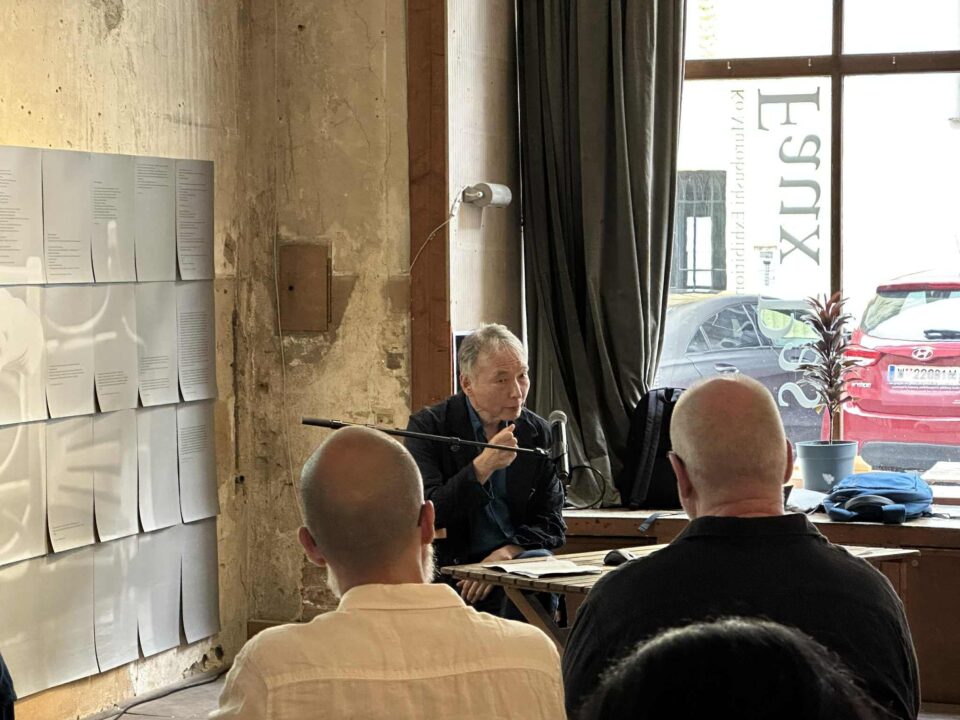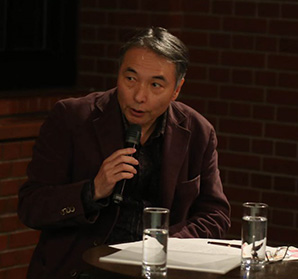ダンスあるいは踏み外し

ダンスは測り知れない。ダンスだけではないが、ダンスに固有の、何か測りがたいものがある。それゆえ測り知れないものとしてダンスを生き、考え、追求する踊り手たちがいる。それはまた踊る身体が、測り知れないものだということでもある。ただ一個の身体が踊っているのではなく、同時にそこに感覚や記憶や思考が入り乱れて踊っているとすれば、それらの一つ一つも、全体も、測り知れないということである。
踊り手はダンス自体を問いながら踊るだろう。しかしダンス自体というものがあるかどうか確かではない。ダンスはそれ以外のものに開かれ、連結されているからだ。この果てしない世界、社会にも自然にも、人間にも生活にも、無数の生命や物にも浸透されている。室伏鴻はそれらすべてを相手にして踊りを追求しながら、踊り続けた。踊りはあまりに世界に向けて開いているので果てしなく、決して達成されることはないまま、追求されるしかない。「このトリトメのなさは、なんなのだろう?」と独語しながら彼はそれを続けた。
室伏は、ダンスと言葉のあいだを、おびただしく往復した。ダンスと言葉のあいだに激しい衝突、貫入、溶融、緊張が持続していたようだ。土方巽から、直接、間接に受けた影響を、彼は反芻し、吟味し、診断し続けた。
土方の舞踏の創造は、早くから独自の機敏な詩的思考とともにあった。ダンスと言語の間に起きた交差(キアスム)の目覚ましい例としては、土方も着目していたニジンスキーのバレーと手記という例が浮かんでくるが、舞台に立つことをやめてからも『病める舞姫』という本に注がれた言語的創造は、舞踏の生成にとって不可欠の要素だったのだ。土方が鍛え上げた言葉は、そのまま舞踏の身体を追求し発見する過程であり、それはダンスの説明でも理論でもなく、台本でもシノプシスでもなく、作業ノートでもなく、舞踊家の回想録でもなかった。大野一雄、笠井叡の創造もその例外ではなく、しばしば舞踏は、それ自体がダンスでもある言語の、意味を貫通する濃密な振動や力線に密着して実現されたのだ。その点でも際立っていたのは土方巽であり、ただ彼一人に属する舞踏‐言語の生成過程が確かにあった。
室伏鴻は、土方のこの言語行為にも敏感に反応しながら、土方の創造の核にある思考を受け止めようとした。土方自身が室伏の追求に応答し、その進路を「苛烈な無為」と形容する美しい一文(「木乃伊の舞踏―室伏鴻」)を寄せていた。
それなら、土方にも室伏にも深く関与するらしいこの「無為」とは何か。「舞踏」にとって無為とは何か。それはダンスの「測り知れなさ」を突きぬける強靭な無意味なのではないか。
すでにこの追求のエッセンスを収めた『室伏鴻集成』や、公開されたアーカイブ中のテクストなどの他にも、まだ未公開の室伏の手記が残されている。それらの中で彼は、既成のダンス、あるいはみずからのダンス自体にも、しばしば強度の否定を向け、ダンスに死刑宣告するようにして、そのつど蘇生の道をさぐっている。「舞踏」に触発されてきたモチーフを決して棄ててはいなかったが、その無為のダンスは、あらゆる形式をかなぐりすてていた。マテリアル、分子、溶けること、崩れること、外れること……がつねに追求されている。
ブランショの言葉Faux-pas(踏み外し)が、一つの合言葉のようになった。ダンスのパ(ステップ)を逸脱すること、転倒し脱臼すること、そして死に損なうこと。土方の「舞踏とは突っ立った死体」という言葉はあまりにも有名になったが、決してそれは死者の舞踏(ダンス・マカーブル)のことではない。それは生きた死体の踊りであり、死体になる踊り、反実現の踊りなのだ。
初期の室伏の発想は暴力的である。「忍耐をこえる痛み、陶酔は、私を喪失させる。無我の、呆気の境にあるのもまた、舞踏の祖である。/私は私を舞踏場に殺害する。が私は不死であり甦るものだ」。しかしその発想を保ちながら、長くダンサーたちと協働する中で、常軌を逸脱する身振り、状態、変化に微細な注意をむけるレッスンを繰り返し、ダンスの無為を追求し続けた。
測り知れない、果てしないダンスを追求するとは、またさまざまな限界(「存在の際、縁、隅、鄙……」)を知覚し、吟味し、体験し、ときには通り過ぎることでもある。そもそも身体の能力は有限にちがいないが、身体は果てしないものでもある。身体の形態も力も、はてしない変化、様態をくぐりぬけていくからである。たった一つの身振りの線も、いくつもの方向と分岐と振動をはらんでいる。ある痙攣の状態から、別の動態に移っていくとき、室伏のゆるやかな身振りから、いくつもの切子面がきらめき出るような瞬間を見たことがある。
この探求の軌跡を展示する試みは、有限の場所を果てしないものに開く実験となるはずだ。それと同時に《限界》の意味自体が変わらなければならないだろう。
Quoted texts in the conference by Kuniichi Uno :
Singularly indefinable diseases
Antonin Artaud, Theater and it’s double, tr.Mary Caroline Richard’s, Grove Press New York,1958
“Whatever the errors of historians or physicians regarding the plague, [writes Artaud,] I believe we can agree on the idea of a malady that would be a sort of psychic entity and would not be brought on by a virus.” (18, tr. mod)
“Everything portends an organic storm without precedent.” (19)
But it “most often indicates that the life at its center has lost nothing of its There are always these lived sinuosities of intense and subtle movements between forms, between organs.
strength, and that a remission of the illness, or even a cure, is possible.”
“All indications point to a fundamental disordering of the secretions. Yet there is no loss or destruction of matter as in the case of leprosy or syphilis. The intestines themselves, which are the site of the bloodiest disorders of all, where matter arrives at an unparalleled degree of putrefaction and petrification, are not attacked organically.” (20)
“The only two organs truly affected and damaged by the plague, the brain and the lungs, are both directly dependent on consciousness and will.” (21)
In short the plague, which “would be a kind of psychic entity,” in Artaud’s words, does not destroy the corporeal matter, does not afflict it organically (21).
All of which in short demonstrates the “spiritual physiognomy of an illness”. (22)
“If it requires a major scourge to bring into appearance that frenetic gratuitousness [or excess], and if that scourge is called a plague, perhaps we can determine, in relation to the totality of our personality, the value of that gratuitousness …Everything about the physical appearance of the actor, as of the person who has been afflicted by the plague, shows that the life form has reacted to a paroxysm, and that nonetheless, nothing has occurred.” (24)
Correspondence with Jacques Rivière in Selected writings edited by Susan Sontag, New York : Farrar, Straus and Giroux,1976
“My thought abandons me at every level. From the simple fact of thought to the external fact of its materialization in words.” “It is a question of (…) a total absence, a real extinction” (31) .
It is true that the one who says these sentences articulates this loss, “this complete nothingness,” with great eloquence, and he demands the absolute right to express “the substance of [his] thought,” the right to “continue to think” even in paralysis.
In another letter, he elucidates his “case” more closely, attributing it “to a central collapse of the soul, to a kind of erosion of thought, both essential and fleeting, to the temporary non-possession of the material benefits of [his] development, to the abnormal separation of the elements of thought,” and so on. He points out what diminishes his “mental tension,” which “gradually destroys the mass of [his] thought in its substance” (34-35)
“Restore to my mind the concentration of its forces, the cohesion that it lacks, the constancy of its tension, the consistency of its own substance.”(35)
“that I am not in the world, and [the problem] is not a simple matter of my mental attitude.” It is: “The poison of being itself. A veritable paralysis, a sickness which deprives you of speech and memory, pulls up your thought by the roots.”(45)
“Never, when it is life itself that is leaving…” Artaud, in the preface to The Theater and Its Double, thus immediately raises the question of life, speaking of “this generalized collapse of life.” “The most urgent thing” in his view is to extract from what we call culture (and therefore theater), “ideas whose compelling force is identical to that of hunger.”
But what is at stake in this case is “our simple strength [or force] to be hungry.”
No doubt, we will need to “brutalize forms” (in Artaud’s words) to reconnect with what survives underneath or behind these forms. We must not linger on the forms themselves, as Artaud writes: “when we speak the word life, it must be understood we are not referring to life as we know it in its exterior facts, but to that fragile and fluctuating source which forms never reach.” (13)
And if theater is to be reforged as one kind of language, “the important thing is to move in stages, creating perspectives from one language to another. The secret of theater in space is dissonance, the gap between timbres, and the dialectical discontinuity of expression.” (in Theater and its double)
Murobushi’s writings (in Murobushi Ko shūsei, Kawade Shobō Shinshu,2018)
“Repeating,
Repeating, to be yourself identical to yourself, to be myself identical to myself
It is the only way, living while dying, until the point of becoming a perfect corpse,
Thus
It is life that is the very body of death overlayered” (p. 338)
“So, to dance is to lose oneself. Dance makes one lose oneself. It is dance that makes dance lose itself. If this is so, then who is it that then stands up? Is it possible to stand? It is a corpse. My own corpse dances, since in this moment, dance becomes a place for the genesis of another. It is the coming into being of an unknown thing.
Otherwise, what is it? Repetition, the coming of the same thing, yet there is nothing the same. Eternity returns. “It is found again, what? Eternity.” (Rimbaud) » (p.345)
“The experience of Ankoku Butoh began with a throw of the dice, un coup de dès.
And after half a century, even now, over and over one must continue to throw the dice.
What is the outside? The formless present, impossible to continue being, by always already being there; the impossibility of remaining for the ‘now, here’ that passes already transformed at the moment it is designated; and the non-place, place without place of a no one without person, where the body, the dance, arises, bringing into action the flesh.” (p.347)
I would echo those phrases:
Writing to pass into this zone of impossible death, this repetition, in order to give oneself to the impossible, to unravel the impossible, to dance this invisible halo: this is not mysticism, but a simple and perhaps animalistic gesture of an unknown animal.
Wilhelm Worringer Abstraction and Einfühlung (Empathy)
“Although the ornament is founded on a purely linear and inorganic basis, we hesitate to call it abstract ornament. Rather, we cannot help seeing there a disquieting life in the interlacing of the lines. This disquiet, this groping interlacing, does not possess an organic life that could introduce us gently into movement. But that does not mean that there is no life within. Rather we find there an intense, frenetic life that compels us to follow its movement into unhappy feeling. On an inorganic basis, we find vitalizing movements and expressions.”
Profile

宇野邦一Kuniichi Uno
フランス文学者・批評家・前立教大学映像身体学科教授。身体論、身体哲学を焦点としながらエセーを書き続けている。著書に『アルトー 思考と身体』(白水社)、『土方巽』(みすず書房)、『ベケットのほうへ』(五柳書院)、『非有機的生』(講談社)、『パガニスム』(青土社)、訳書にドゥルーズ/ガタリ『アンチ・オイディプス』、アルトー『神の裁きと訣別するため』(河出文庫)、ドゥルーズ『フーコー』『襞』『フランシス・ベーコン』、ベケット『モロイ』『どんなふう』(河出書房新社)などがある。